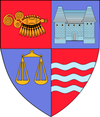- Reghin
-
Reghin
Szászrégen— Municipality — 
Coat of armsLocation of Reghin Coordinates: 46°46′33″N 24°42′30″E / 46.77583°N 24.70833°ECoordinates: 46°46′33″N 24°42′30″E / 46.77583°N 24.70833°E Country  Romania
RomaniaCounty Mureş County Status Municipality Government – Mayor András Nagy (Democratic Union of Hungarians in Romania) Area – Total 56.09 km2 (21.7 sq mi) Population (2003) – Total 36,173 Time zone EET (UTC+2) – Summer (DST) EEST (UTC+3) Website http://www.primariareghin.ro/ Reghin (Romanian pronunciation: [ˈreɡin]; Hungarian: Szászrégen, Hungarian pronunciation: [’saːsreːɡɛn] or Régen; German: (Sächsisch) Regen) is a city and municipality in Mureş county in Romania, on the Mureş River in Transylvania. It is the place of origin of the Sasregen Hasidic Jewish dynasty. It had a population of approximately 35,700 in 2004.
Contents
Location
Reghin lies 29 km north-northeast of Târgu Mureş, extending on both shores of the Mureş River, at the confluence with the Gurghiu River. It was created by the 1926 union of the German-inhabited (formerly Szászrégen) and the Hungarian-inhabited (formerly Magyarrégen) city, and later joined with the two smaller communities of Apalina (Hungarian: Abafája; German: Bendorf) and Iernuţeni (Hungarian: Radnótfája; German: Etschdorf), added in 1956.
History
Reghin was first mentioned in 1228 in a charter of Hungarian King Andrew II as Regun - however, evidence of its strategic location and defence system suggests that the town might have been considerably older, possibly founded during by Ladislaus I.
Despite the devastations of the city during the Mongol invasion (1241) and during the Tatar and Cuman incursions (1285), the town developed rapidly: already in the second half of the 13th century the city was the residence and power centre of the families Tomaj and Kacsik, to whom the nearby lands were awarded by the Hungarian Crown. Reghin became a minor ecclesiastical centre in 1330, with the building of the Gothic church (Roman Catholic at the time, it now serves the Protestant community) in the German part of the city; it is still the largest church in the area, and hosts the oldest Medieval Latin inscription of any church in Transylvania. The Hungarian part of the city has an even older church, initially built in the Romanesque style.
At the beginning of the 15th century the settlement gained city rights, and, from 1427, the right to hold fairs. In the 16th and 17th century Reghin was devastated by Habsburg and Ottoman troops on several occasions. It burned to the ground in 1848. In 1910, the population of the city included 7,310 inhabitants, of which 2,994 were Germans (Transylvanian Saxons), 2,947 Hungarians, and 1,311 Romanians. [1]
In 1920 Reghin was assigned to Romania by the Treaty of Trianon, together with the rest of Transylvania. In 1940, as result of the Second Vienna Award, the city became part of Hungary, together with the North of Transylvania. Almost 30% of the inhabitants were Jews at that time. In May 1944, the Jews were gathered in the ghetto of Reghin and on June 4, 1944 were deported to Auschwitz. In 1945 the city again became part of Romania.
After World War II, Reghin lost some of its former Transylvanian Saxon character - as many Germans left for Western Germany during the latter stages of Communist Romania - and ethnic Romanians were settled in their place. The data of the 1992 census showed a population of 24,601 Romanians, 12,471 Hungarian, 1,790 Roma, and 346 Germans.
Demographics
Ethnic groups (2002 census [1]):
- Romanians = 23,611 (65.35%)
- Hungarians = 10,396 (28.77%)
- Gypsies = 1,831 (5.06%)
- Germans = 237 (0.65%)
- others.
Landmarks
Traditional German architectural heritage:
- the Protestant (Lutheran) church, built in 1330 in honour of Saint Mary. Burnt down in 1708 and in 1848, after which it had been rebuilt.
- the Roman Catholic church, which was consecrated in 1781.
Traditional Hungarian architectural heritage:
- the Protestant (Calvinist) church, 13th century, in 1910 completely rebuilt.
- a Calvinist church built in 1890.
Traditional Romanian architectural heritage:
- the Greek-Catholic church, built in 1744, nowadays Romanian Orthodox.
- the Greek-Catholic church, built between 1811 and 1813, nowadays Romanian Orthodox.
New landmarks:
- a Romanian Orthodox Cathedral was built in the city in the 1990s.
- the renowned zoological and folklore collections.
People
- Josef Haltrich (1822–1886), ethnographer, historian.
- Ferenc Kós (b. 1828), writer
- Rudolf Wagner-Régeny (1903–1969), composer
- Georg Maurer (1907–1971), writer
- Jutta Pallos-Schönauer (b.1925), Painter
- Petru Maior (1756–1821), Writer and Educator
- Vasile Gliga, luthier and successful businessman
- Viorel Frunza, miniature luthier
International relations
Main article: List of twin towns and sister cities in RomaniaTwin towns — Sister cities
Reghin is twinned with:
 Ungheni, Republic of Moldova
Ungheni, Republic of Moldova
Images
See also
- List of Hungarian exonyms (Mureş County)
Notes
Categories:- Cities in Romania
- Populated places in Mureș County
Wikimedia Foundation. 2010.










